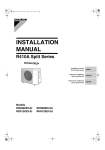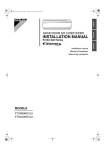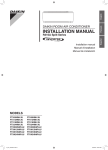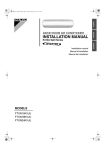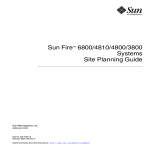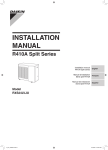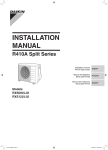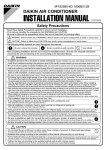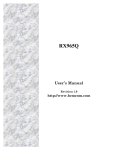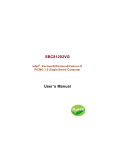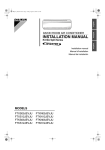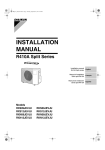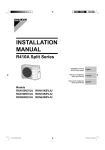Download Daikin RX15FVJU Installation manual
Transcript
3P228446-2B M08B128 DAIKIN AIR CONDITIONER Two-dimensional bar code is a code for manufacturing. Safety Precautions • Read these Safety Precautions carefully to ensure correct installation. • This manual classifies the precautions into DANGER, WARNING and CAUTION. Be sure to follow all the precautions below: they are all important for ensuring safety. DANGER Indicates an imminently hazardous situation which, if not avoided, will result in death or serious injury. WARNING Failure to follow any of WARNING is likely to result in such grave consequences as death or serious injury. CAUTION Failure to follow any of CAUTION may in some cases result in grave consequences. • The following safety symbols are used throughout this manual: Be sure to observe this instruction. Be sure to establish an earth connection. Never attempt. • After completing installation, test the unit to check for installation errors. Give the user adequate instructions concerning the use and cleaning of the unit according to the Operation Manual. DANGER • Refrigerant gas is heavier than air and replaces oxygen. A massive leak could lead to oxygen depletion, especially in basements, and an asphyxiation hazard could occur leading to serious injury or death. • If the refrigerant gas leaks during installation, ventilate the area immediately. Refrigerant gas may produce a toxic gas if it comes in contact with fire such as from a fan heater, stove or cooking device. Exposure to this gas could cause severe injury or death. • After completing the installation work, check that the refrigerant gas does not leak. Refrigerant gas may produce a toxic gas if it comes in contact with fire such as from a fan heater, stove or cooking device. Exposure to this gas could cause severe injury or death. • Do not ground units to water pipes, telephone wires or lightning rods because incomplete grounding could cause a severe shock hazard resulting in severe injury or death, and to gas pipes because a gas leak could result in an explosion which could lead to severe injury or death. • Safely dispose of the packing materials. Packing materials, such as nails and other metal or wooden parts, may cause stabs or other injuries. Tear apart and throw away plastic packaging bags so that children will not play with them. Children playing with plastic bags face the danger of death by suffocation. • Do not install unit in an area where flammable materials are present due to risk of explosion resulting in serious injury or death. • Do not ground units to telephone wires or lightning rods because lightning strikes could cause a severe shock hazard resulting in severe injury or death, and to gas pipes because a gas leak could result in an explosion which could lead to severe injury or death. WARNING • Installation should be left to the authorized dealer or another trained professional. Improper installation may cause water leakage, electrical shock, fire, or equipment damage. • Install the air conditioner according to the instructions given in this manual. Incomplete installation may cause water leakage, electrical shock, fire or equipment damage. • Be sure to use the supplied or exact specified installation parts. Use of other parts may cause the unit to come to lose, water leakage, electrical shock, fire or equipment damage. • Install the air conditioner on a solid base that is level and can support the weight of the unit. An inadequate base or incomplete installation may cause injury or equipment damage in the event the unit falls off the base or comes loose. • Electrical work should be carried out in accordance with the installation manual and the national, state and local electrical wiring codes. Insufficient capacity or incomplete electrical work may cause electrical shock, fire or equipment damage. • Be sure to use a dedicated power circuit. Never use a power supply shared by another appliance. Follow all appropriate electrical codes. • For wiring, use a wire or cable long enough to cover the entire distance with no splices if possible. Do not use an extension cord. Do not put other loads on the power supply. Use a only a separate dedicated power circuit. (Failure to do so may cause abnormal heat, electric shock, fire or equipment damage.) • Use the specified types of wires for electrical connections between the indoor and outdoor units. Follow all state and local electrical codes. Firmly clamp the interconnecting wires so their terminals receive no external stresses. Incomplete connections or clamping may cause terminal overheating, fire or equipment damage. Safety Precautions WARNING • After connecting all wiring be sure to shape the cables so that they do not put undue stress on the electrical covers, panels or terminals. Install covers over the wires. Incomplete cover installation may cause terminal overheating, electrical shock,fire or equipment damage. • When installing or relocating the system, be sure to keep the refrigerant circuit free from all substances other than the specified refrigerant (R410A), such as air. (Any presence of air or other foreign substance in the refrigerant circuit causes an abnormal pressure rise which may result in rupture, resulting in injury.) • During pump-down, stop the compressor before removing the refrigerant piping. If the compressor is still running and the stop valve is open during pump-down, air will be sucked in when the refrigerant piping is removed, causing abnormally high pressure which could lead to equipment damage or and personal injury. • During installation, attach the refrigerant piping securely before running the compressor. If the compressor is not attached and the stop valve is open during pump-down, air will be sucked in when the compressor is run, causing abnormally high pressure which could lead to equipment damage and personal injury. • Be sure to install a ground fault circuit interrupter breaker. Failure to install a ground fault circuit interrupter breaker may result in electrically shocks, or fire personal injury. CAUTION • Do not install the air conditioner where gas leakage would be exposed to open flames. If the gas leaks and builds up around the unit, it may catch fire. • Establish drain piping according to the instructions of this manual. Inadequate piping may cause water damage. • Tighten the flare nut according to the specified torque. A torque wrench should be used. If the flare nut is tightened too much, the flare nut may crack over time and cause refrigerant leakage. • Do not touch the heat exchanger fins. Improper handling may result in injury. • Be very careful about product transportation. Some products use PP bands for packaging. Do not use any PP bands for a means of transportation. It is dangerous. Accessories A Mounting plate 1 Mounting plate fixing screws 3/16” × 1”L (M4 × 25L) Titanium Apatite Photocatalytic C Air-Purifying Filter B D Wireless remote controller 9 3 1 E Remote controller holder Fixing screws for remote controller holder 1/8” × 13/16”L (M3 × 20L) Dry batteries AAA. LR03 G (alkaline) Indoor unit fixing screws H 3/16” × 1/2”L (M4 × 12L) F Tube 1 J 2 K Operation manual 1 2 L Installation manual 1 3 M Screw cover 3 1 Choosing an Installation Site • Before choosing the installation site, obtain user approval. 1. Indoor unit. • 1) 2) 3) 4) 5) 6) 7) The indoor unit should be sited in a place where: the restrictions on installation specified in the indoor unit installation drawings are met, both air intake and exhaust have clear paths met, the unit is not in the path of direct sunlight, the unit is away from the source of heat or steam, there is no source of machine oil vapour (this may shorten indoor unit life), cool (warm) air is circulated throughout the room, the unit is away from electronic ignition type fluorescent lamps (inverter or rapid start type) as they may shorten the remote controller range, 8) the unit is at least 3.5ft (1m) away from any television or radio set (unit may cause interference with the picture or sound), 9) install at the recommended height (6ft (1.8m)). 2. Wireless remote controller. 1) Turn on all the fluorescent lamps in the room, if any, and find the site where remote controller signals are properly received by the indoor unit (within 23ft (7m)). Indoor Unit Installation Drawings A Mounting plate The mounting plate should be installed on a wall which can support the weight of the indoor unit. How to attach the indoor unit. Hook the claws of the bottom frame to the mounting plate. If the claws are difficult to hook, remove the front grille. How to remove the indoor unit. Push up the marked area (at the lower part of the front grille) to release the claws. If it is difficult to release, remove the front grille. A Mounting plate Clip Bottom frame Front grille Mark (rear side) B Mounting plate fixing screws 3/16” × 1”L (M4 × 25L) (9) 1-3/16” (30mm) or more from ceiling Front panel Caulk pipe hole gap with putty. Cut thermal insulation pipe to an appropriate length and wrap it with tape, making sure that no gap is left in the insulation pipe’s cut line. Wrap the insulation pipe with the finishing tape from bottom to top. 1-15/16” (50mm) or more from walls (on both sides) 3/16” × 5/8”L (M4 × 16L) Intelligent-eye sensor 3/16” × 5/8”L (M4 × 16L) 3/16” × 5/8”L (M4 × 16L) M Screw cover Service lid Opening service lid Service lid is opening/closing type. Opening method 1) Remove the service lid screws. 2) Pull out the service lid diagonally down in the direction of the arrow. 3) Pull down. Front grille fixture How to remove front grille fixture 1) Insert the tool into the groove of the front grille fixture. Air filters Front grille fixture Bottom of indoor unit 2) Turn the tool 90˚ in the direction of the arrow. C Titanium Apatite Photocatalytic Air-Purifying Filter (3) Titanium Apatite Photocatalytic Air-Purifying Filter 3) Take out the front grille fixture. Filter frame Tab Air filter D Wireless remote controller F Fixing screws for remote controller holder 1/8” × 13/16”L (M3 × 20L) (2) Before screwing the remote controller holder to the wall, make sure that control signals are properly received by indoor unit. E Remote controller holder Intelligent-eye Sensor CAUTION 1) Do not hit or violently push the intelligent-eye sensor. This can lead to damage and malfunction. 2) Do not place large objects near the sensor. Also keep heating units or humidifiers outside the sensor’s detection area. Installation Tips <When there is no work space because the unit is close to ceiling> 1. Removing and installing front panel. • Removal method Hook fingers on the panel protrusions on the left and right of the main body, and open until the panel stops. Slide the front panel sideways to disengage the rotating shaft. Then pull the front panel toward you to remove it. Be sure to wear protection gloves. Place both hands under the center of the front grille, and while pushing up, pull it toward you. Push the rotating shaft of the front panel into the groove. 3. How to set the different addresses. When 2 indoor units are installed in 1 room, the 2 wireless remote controllers can be set for different addresses. ¡¡¡ mark area Upper hook (4 locations) 2) Remove the front grille. 3) In front of the mark of the front grille, there are 4 upper hooks. Lightly pull the front grille toward you with one hand, and push down on the hooks with the fingers of your other hand. Lightly pull the front grille toward you with one hand, and push down on the hooks with the fingers of your other hand. (4 locations) 2) Pull toward you. • Installation method 1) Install the front grille and firmly engage the upper hooks (4 locations). 2) Install 6 screws of the front grille. 3) Install the air filter and then mount the front panel. 2. Removing and installing the front grille. • Removal method 1) Remove front panel to remove the air filter. 1) Push up. Push down. Upper hook Upper hook ADDRESS • Installation method Align the tabs of the front panel with the grooves, and push all the way in. Then close slowly. Push the center of the lower surface of the panel firmly to engage the tabs. CAUTION JA JA ADDRESS EXIST CUT 1 2 1) In the same way as when connecting to an HA system, remove the metal plate electrical wiring cover. J4 2) Cut the address jumper (JA) on the printed circuit board. 3) Cut the address jumper (J4) in the remote controller. J4 ADDRESS EXIST CUT 1 2 Indoor Unit Installation (1) 1. Installing the mounting plate. • The mounting plate should be installed on a wall which can support the weight of the indoor unit. 1) Temporarily secure the mounting plate to the wall, make sure that the panel is completely level, and mark the boring points on the wall. 2) Secure the mounting plate to the wall with screws. Recommended mounting plate retention spots and dimensions * The removed pipe port cover can be kept in the mounting plate pocket. (Bolt size: 3/8” (M10)) Recommended mounting plate retention spots (9 spots in all) (Bolt size: 3/8” (M10)) Place a leveler on raised tab. (Bolt size: 3/8” (M10)) 5-1/4 (134) A Mounting plate 2. φ3-1/8 (φ80) 2-9/16 Drain (65) hose position φ3-1/8 (φ80) 1-3/4 (45) 1-3/4 (45) Removed pipe port cover 7-1/2 (190) 13-3/8 (340) 2-1/16 (53) 5-3/16 (131) 6-5/16 (161) Gas pipe end 21-13/16 (554) 47-1/4 (1200) Through-the-wall hole φ3-1/8 inch (φ80mm) 1-7/8 (47) Liquid pipe end 7-3/16 (183) 3-1/2 (89) Use tape measure as shown. Position the end of a tape measure at ∇. (length: inch (mm)) Keep here the piece cut out from the unit for piping Boring a wall hole and installing wall embedded pipe. • For walls containing metal frame or metal board, be sure to use a wall embedded pipe and wall cover in the feed-through hole to prevent possible heat, electrical shock, or fire. • Be sure to caulk the gaps around the pipes with caulking material to prevent water leakage. 1) Bore a feed-through hole of 3-1/8 inch (80mm) in the wall so it has a down slope toward the outside. 2) Insert a wall pipe into the hole. 3) Insert a wall cover into wall pipe. 4) After completing refrigerant piping, wiring, and drain piping, caulk pipe hole gap with putty. Inside Wall embedded pipe (Field supply) Wall hole cover (Field supply) Outside Caulking φ3-1/8” (φ80mm) Wall embedded pipe (Field supply) Indoor Unit Installation (2) 3. Installing indoor unit. 3-1. Right-side, right-back, or right-bottom piping. 1) Attach the drain hose to the underside of the refrigerant pipes with an adhesive vinyl tape. Remove pipe port cover here for right-side piping. 2) Wrap the refrigerant pipes and drain hose together with an insulation tape. Right-back piping Right-bottom piping Remove pipe port cover here for right-bottom piping. Bind coolant pipe and drain hose together with insulation tape. A Mounting plate 3) Pass the drain hose and refrigerant pipes through the wall hole, then set the indoor unit on the mounting plate hooks by using the markings at the top of the indoor unit as a guide. 4) Open the front panel, then open the service lid. (Refer to Installation Tips.) 5) Pass the inter-unit wiring from the outdoor unit through the feedthrough wall hole and then through the back of the indoor unit. Connect the inter-unit wiring. (Refer to 4. Wiring.) 6) Press the bottom frame of the indoor unit with both hands to set it on the mounting plate hooks. Make sure that the wires do not catch on the edge of the indoor unit. 3-2. Left-side, left-back, or left-bottom piping. Remove pipe port cover here for left-side piping. 1) Attach the drain hose to the underside of the refrigerant pipes with adhesive vinyl tape. 2) Be sure to connect the drain hose to the drain port in place of a drain plug. Left-side piping Remove pipe port cover here for left-bottom piping. Left-bottom piping How to set the drain hose. • Insert drain hose and tighten indoor unit fixing screw. (Forgetting to attach this may cause water leakages.) How to set the drain plug. ap No g * The drain hose is on the back of the unit. Attachment on the left side Drain hose attachment position Attachment on the right side (factory default) Indoor unit fixing screw Insulation fixing screw Drain hose Drain hose Insert a hexagon wrench (3/16 inch (4mm)) Front side of unit Left-back piping Do not apply lubricating oil (refrigerant oil) when inserting. Application of causes deterioration and drain leakage of the plug. 3) Shape the refrigerant pipe along the pipe path marking on the mounting plate. 4) Pass drain hose and refrigerant pipes through the wall hole, then set the indoor unit on mounting plate hooks, using the markings at the top of indoor unit as a guide. 5) Pull in the inter-unit wiring. Drain hose Caulk this hole with putty or caulking material. A Mounting plate Bind with plastic tape. 6) Connect the inter-unit piping. 7) Wrap the refrigerant pipes and drain hose together with insulation tape as right figure, in case of setting the drain hose through the back of the indoor unit. 8) While exercising care so that the inter-unit wiring do not catch indoor unit, press the bottom edge of indoor unit with both hands until it is firmly caught by the mounting plate hooks. Secure indoor unit to the mounting plate with the screws (3/16” × 1/2”L (M4 × 12L)). 3-3. Wall embedded piping. Follow the instructions given under Left-side, left-back, or left-bottom piping . 1) Insert the drain hose to this depth so it won’t be pulled out of the drain pipe. Wrap insulation tape around the bent portion of refrigerant pipe. Overlap at least half the width of the insulation tape with each turn. Inter-unit wiring A Drain hose Mounting plate Refrigerant pipes Bottom frame H 3/16” × 1/2”L (M4 × 12L) (3 point) Insert drain hose to this depth so it won’t be pulled out of drain pipe. 1-15/16” (50mm) or more Outer wall Inner wall Drain hose Vinyl chloride drain pipe (VP-30) Indoor Unit Installation (3) 4. Wiring. Terminal block 1) As shown in the illustration on the right-hand side, insert the wires including the ground wire into the conduit and secure them with lock nut onto the conduit mounting plate. 2) Insert the wires including the ground wire into J tube. J Tube 3) Strip wire ends (9/16 inch (15mm)). 4) Match wire colors with terminal numbers on indoor and outdoor unit’s terminal blocks and firmly screw wires to the corresponding terminals. 5) Connect the ground wires to the corresponding terminals. 6) Pull the wires and check that the wires are securely fixed to the terminal block. 7) In case of connecting to an adapter system, run the remote controller cable and attach the S21. (Refer to 5. When connecting to an HA system.) 8) Shape the wires so that the service lid fits securely, then close service lid. Electrical component box Wire retainer Shape wires so that the service lid will fit securely. Use the specified wire type. Back Lock nut Conduit mounting plate Conduit Outdoor unit When wire length exceeds 33ft (10m), use AWG14 wires. Indoor unit 1 23 LN 3 2 1 Use AWG16 or AWG14 wire for the Interconnecting wires WARNING 1) Do not use tapped wires, stranded wires, extensioncords, or starburst connections, as they may cause overtheating, electrical shock,or fire. 2) Do not use locally purchased electrical parts inside the product. (Do not branch the power for the drain pump, etc., from the terminal block.) Doing so may cause electric shock or fire. 3) When carrying out wiring connection, take care not to pull at the conduit. 5. When connecting to an HA system. HA connector (S21) 1) Remove the front grille. Pull Pull (6 screws, 3 front grille fixtures) 2) Remove the electrical Slide Tab wiring box. (1 screw) Lay the HA cord as shown in the figure. 3) Remove the metal plate HA connector electrical wiring cover. Screw Slide (S21) Metal plate 4) Attach the connection (4 tabs) 5) Replace the electrical wiring cover as it was, cord to the S21 electrical cover and pull the harness connector and pull 4) Attach the connection around, as shown the harness out 3) Remove the metal plate in the figure. through the notched electrical wiring cover. cord to the S21 connector Main body part in the figure. and pull the harness out through the notched part in the figure. 5) Replace the electrical wiring cover as it was, and pull the harness around, as shown in the figure. Tab Drain piping. The drain hose should be inclined downward. 3) When drain hose requires extension, obtain an extension hose commercially available. Be sure to thermally insulate the indoor section of the extension hose. No trap is permitted. Indoor unit drain hose φ11/16” (φ18mm) 1) Connect the drain hose, as described below. Extension drain hose Do not put the end of the hose in water. Heat insulation tube (Field supply) 2) Remove the air filters and pour some water into the drain pan to check the water flows smoothly. 4) When connecting a rigid polyvinyl chloride pipe (nominal diameter 1/2 inch (13mm)) directly to the drain hose attached to the indoor unit as with embedded piping work, use any commercially available drain socket (nominal diameter 1/2 inch (13mm)) as a joint. φ11/16” (φ18mm) 6. Drain hose supplied with the indoor unit Commercially available drain Commercially available rigid socket polyvinyl chloride pipe (nominal diameter 1/2 inch (13mm)) (nominal diameter 1/2 inch (13mm)) Refrigerant Piping Work 1. Flaring the pipe end. (Cut exactly at right angles.) 1) Cut the pipe end with a pipe cutter. 2) Remove burrs with the cut surface facing downward so that the chips do not enter the pipe. 3) Put the flare nut on the pipe. 4) Flare the pipe. 5) Check that the flaring is properly made. Remove burrs Flaring Set exactly at the position shown below. A Die A Flare tool for R410A Conventional flare tool Clutch-type Clutch-type (Rigid-type) Wing-nut type (Imperial-type) 0-0.020 inch (0-0.5mm) 0.039-0.059 inch (1.0-1.5mm) 0.059-0.079 inch (1.5-2.0mm) Check Flare’s inner surface must be flaw-free. The pipe end must be evenly flared in a perfect circle. Make sure that the flare nut is fitted. WARNING 1) Do not use mineral oil on flared part. 2) Prevent mineral oil from getting into the system as this would reduce the lifetime of the units. 3) Never use piping which has been used for previous installations. Only use parts which are delivered with the unit. 4) Never install a drier to this R410A unit in order to guarantee it’s lifetime. 5) The drying material may dissolve and damage the system. 6) Incomplete flaring may cause refrigerant gas leakage. 2. Refrigerant piping. CAUTION 1) Use the flare nut fixed to the main unit. (To prevent cracking of the flare nut by aged deterioration.) 2) To prevent gas leakage, apply refrigeration oil only to the inner surface of the flare. (Use refrigeration oil for R410A.) 3) Use torque wrenches when tightening the flare nuts to prevent damage to the flare nuts and gas leakage. Align the centers of both flares and tighten the flare nuts 3 or 4 turns by hand. Then tighten them fully with the torque wrenches. Do not apply refrigeration oil to the outer surface. [Tighten] [Apply oil] Apply refrigeration oil to the inner surface of the flare. Flare nut Spanner Do not apply refrigeration oil to the flare nut to avoid tightening with over torque. Flare nut tightening torque Torque wrench Gas side Liquid side 5/8 inch (15.9mm) 3/8 inch (9.5mm) 45.6-55.6ft l lbf (61.8-75.4N l m) 24.1-29.4ft l lbf (32.7-39.9N l m) Piping union Flare nut 2-1. Caution on piping handling. 1) Protect the open end of the pipe against dust and moisture. 2) All pipe bends should be as gentle as possible. Use a pipe bender for bending. Rain Be sure to place a cap. Wall If no flare cap is available, cover the flare mouth with tape to keep dirt or water out. 2-2. Selection of copper and heat insulation materials. • When using commercial copper pipes and fittings, observe the following: Inter-unit wiring Gas pipe 1) Insulation material: Polyethylene foam Liquid pipe Heat transfer rate: 0.041 to 0.052W/mK (0.024-0.030Btu/fth˚F (0.035-0.045kcal/mh˚C)) Refrigerant gas pipe’s surface temperature reaches 230˚F (110˚C) max. Choose heat insulation materials that will withstand this temperature. Gas pipe Liquid pipe 2) Be sure to insulate both the gas and liquid piping and to provide insulation insulation Finishing tape Drain hose insulation dimensions as below. Gas side O.D. 5/8 inch (15.9mm) Liquid side Gas pipe thermal insulation Liquid pipe thermal insulation O.D. 3/8inch (9.5mm) I.D. 0.630-0.787 inch (16-20mm) I.D. 0.472-0.591 inch (12-15mm) Minimum bend radius 1-15/16 inch (50mm) or more Thickness 0.393 inch (10mm) Min. 1-3/16 inch (30mm) or more Thickness 0.039 inch (1mm) (C1220T-O) Thickness 0.031 inch (0.8mm) (C1220T-O) 3) Use separate thermal insulation pipes for gas and liquid refrigerant pipes. Pump Down Operation In order to protect the environment, be sure to pump down when relocating or disposing of the unit. Hexagonal 1) Remove the valve cap from liquid stop valve and gas stop valve. wrench Liquid 2) Carry out forced cooling operation. stop valve Close 3) After 5 to 10 minutes, close the liquid stop valve with a hexagonal wrench. 4) After 2 to 3 minutes, close the gas stop valve and stop forced cooling operation. Gas How to force cooling operation mode n Using the indoor unit ON/OFF switch stop valve Valve cap Press the indoor unit ON/OFF switch for at least 5 seconds. (Operation will start.) • Forced cooling operation will stop automatically after around 15 minutes. To stop force cooling operation, press the indoor unit ON/OFF switch. n Using the main unit’s remote controller 1) Press the MODE button and select the cooling mode. 2) Press the ON/OFF button to turn on the system. 3) Press the both of TEMP button and the MODE button at the same time. 4) Press the MODE button twice. ( will be displayed and the unit will enter test run mode.) • Test run mode will stop automatically after around 30 minutes. To stop test run mode, press the ON/OFF button. CAUTION 1) After closing the liquid stop valve, close the gas stop valve within 3 minutes, then stop the forced operation. Trial Operation and Testing (1) 1. Trial operation and testing. 1-1 Measure the supply voltage and make sure that it falls in the specified range. 1-2 Trial operation should be carried out in either cooling or heating mode. 1) In cooling mode, select the lowest programmable temperature; in heating mode, select the highest programmable temperature. Trial operation may be disabled in either mode depending on the room temperature. In that case, use the remote controller for trial operation as described below. 2) After trial operation is complete, set the temperature to a normal level (78˚F to 82˚F (26˚C to 28˚C)in cooling mode, 68˚F to 75˚F (20˚C to 24˚C) in heating mode). • For protection, the system disables restart operation for 3 minutes after it is turned off. 1-3 Carry out the test operation in accordance with the operation manual to ensure that all functions and parts, such as louver movement, are working properly. • The air conditioner requires a small amount of power in its standby mode. If the system is not to be used for some time after installation, shut off the circuit breaker to eliminate unnecessary power consumption. • If the circuit breaker trips to shut off the power to the air conditioner, the system will restore the original operation mode when the circuit breaker is opened again. Trial operation from remote controller. 1) Press the MODE button and select the trial operation mode. (cooling and heating). 2) Press the ON/OFF button to turn on the system. 3) Press the both of TEMP button and the MODE button at the same time. 4) Press the MODE button twice. ( will be displayed and the unit will enter test run mode.) • Test run mode will stop automatically after around 30 minutes. To stop test run mode, press the ON/OFF button. Trial Operation and Testing (2) 2. Test items. Test items Symptom (diagnostic display on RC) Indoor and outdoor units are installed properly on solid bases. Fall, vibration, noise No refrigerant gas leaks. Incomplete cooling/heating function Refrigerant gas and liquid pipes and indoor drain hose extension are thermally insulated. Water leakage Draining line is properly installed. Water leakage System is properly ground to earth. Electrical leakage The specified wires are used for inter-unit wiring connections. Inoperative or burn damage Indoor or outdoor unit’s air intake or exhaust has clear path of air. Stop valves are opened. Incomplete cooling/heating function Indoor unit properly receives remote controller commands. Inoperative Check 3P228446-2B M08B128










